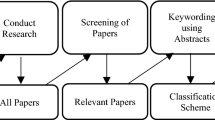Abstract
Concede-and-divide is a widely accepted procedure to solve the problem of adjudicating two conflicting claims. In this paper we show that this procedure can be characterized by combining three standard properties in the literature: self-duality, lower securement, and restricted composition up. We also show that self-duality can be replaced by the dual properties of lower securement and restricted composition up and that both characterization results are tight.
Similar content being viewed by others
References
Aumann RJ, Maschler M (1985) Game theoretic analysis of a bankruptcy problem from the Talmud. J Econ Theory 36: 195–213
Bergantiños G, Méndez-Naya L (2001) Additivity in bankruptcy problems and in allocation problems. Span Econ Rev 3: 223–229
Dagan N (1996) New characterizations of old bankruptcy rules. Soc Choice Welfare 13: 51–59
Dominguez D, Thomson W (2006) A new solution to the problem of adjudicating conflicting claims. Econ Theory 28: 283–307
Herrero C, Villar A (2001) The three musketeers: four classical solutions to bankruptcy problems. Math Soc Sci 42: 307–328
Ju BG, Moreno-Ternero JD (2005) Progressivity, inequality reduction and merging-proofness in taxation. Mimeo, University of Kansas, Kansas
Moreno-Ternero JD, Villar A (2004) The talmud rule and the securement of agents’ awards. Math Soc Sci 47: 245–257
Moreno-Ternero JD, Villar A (2005) New characterizations of a classical bankruptcy rule. Review of Econ Des (in press)
Moreno-Ternero JD, Villar A (2006) The TAL-family of rules for bankruptcy problems. Soc Choice Welfare (in press)
Moulin H (1987) Equal or proportional division of a surplus, and other methods. Int J Game Theory 16: 161–186
Moulin H (2000) Priority rules and other asymmetric rationing methods. Econometrica 68: 643–684
Moulin H (2002) Axiomatic cost and surplus-sharing. In: Arrow K, Sen A, Suzumura K (Eds) The handbook of social choice and selfare, vol. 1. Elsevier, Amsterdam, pp. 289–357
O’Neill B (1982) A problem of rights arbitration from the Talmud. Math Soc Sci 2: 345–371
Thomson W (2003) Axiomatic and game-theoretic analysis of bankruptcy and taxation problems: a survey. Math Soc Sci 45: 249–297
Thomson W (2004) How to divide when there isn’t enough: from the Talmud to modern game theory. Book Manuscript, University of Rochester, Rochester
Yeh C-H (2006) Secured lower bound, composition up, and minimal rights first for bankruptcy problems. Mimeo, Institute of Economics, Academia Sinica, Taiwan
Young P (1988) Distributive justice in taxation. J Econ Theory 44: 321–335
Young P (1994) Equity. Princeton University Press, Princeton
Author information
Authors and Affiliations
Corresponding author
Rights and permissions
About this article
Cite this article
Moreno-Ternero, J.D. Composition, Securement, and Concede-and-divide. SpanEconRev 8, 227–237 (2006). https://doi.org/10.1007/s10108-006-9003-1
Published:
Issue Date:
DOI: https://doi.org/10.1007/s10108-006-9003-1




